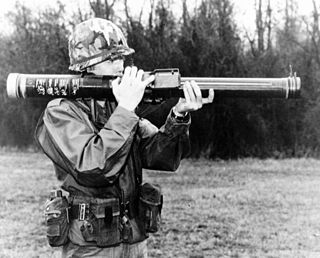 W
WAnti-tank warfare originated from the need to develop technology and tactics to destroy tanks during World War I (1914–1918). Since the Triple Entente developed the first tanks in 1916 but did not deploy them in battle until 1917, the German Empire developed the first anti-tank weapons. The first developed anti-tank weapon was a scaled-up bolt-action rifle, the Mauser 1918 T-Gewehr, that fired a 13mm cartridge with a solid bullet that could penetrate the thin armor of tanks of the time and destroy the engine or ricochet inside, killing occupants. Because tanks represent an enemy's greatest force projection on land, military strategists have incorporated anti-tank warfare into the doctrine of nearly every combat service since. The most predominant anti-tank weapons at the start of World War II in 1939 included the tank-mounted gun, anti-tank guns and anti-tank grenades used by the infantry, as well as ground-attack aircraft.
 W
WThe 2A28 Grom is the main armament of the BMP-1 and BMD-1 infantry fighting vehicles. It is a 73 mm low pressure smoothbore semi-automatic gun with a wedge breech block. Development of the 2A28 Grom was directly linked to that of the SPG-9 recoilless gun; both fired projectiles similar to rocket-propelled grenades.
 W
W55 S 55, colloquially kevyt sinko and nicknamed Nyrkki, was a Finnish recoilless anti-tank weapon from the mid-1950s. The 55 S 55 was designed by a Finnish Defence Forces team led by MSc, Capt Esko Puronto, and it was manufactured by FDF's Vammaskoski factory.
 W
WThe 95 S 58-61 is a heavy recoilless anti-tank weapon used by the Finnish Army. It is also referred to as raskas sinko, or colloquially as Musti ("Blackie"). The weapon was developed in 1958 and it was given a new wheel-equipped carriage in 1961. The name of the weapon means "95 mm, Sinko, model 1958/1961", where sinko is the Finnish word for recoilless weapon.
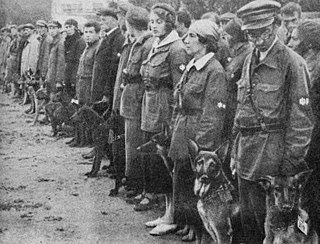 W
WAnti-tank dogs were dogs taught to carry explosives to tanks, armored vehicles and other military targets. They were intensively trained by the Soviet and Russian military forces between 1930 and 1996, and used in 1941–1942, against German tanks in World War II. Initially dogs were trained to leave a timer-detonated bomb and retreat, but this routine was replaced by an impact-detonation procedure which killed the dog in the process. The U.S. military started training anti-tank dogs in 1943 in the same way the Russians used them, but this training exposed several problems and the program was discontinued.
 W
WAn anti-tank gun is a form of artillery designed to destroy tanks and other armored fighting vehicles, normally from a static defensive position. The development of specialized anti-tank munitions and anti-tank guns was prompted by the appearance of tanks during World War I. To destroy hostile tanks, artillerymen often used field guns depressed to fire directly at their targets, but this practice expended too much valuable ammunition and was of increasingly limited effectiveness as tank armor became thicker. The first dedicated anti-tank artillery began appearing in the 1920s, and by World War II was a common appearance in many European armies. To penetrate armor, they fired specialized ammunition from longer barrels to achieve a higher muzzle velocity than field guns. Most anti-tank guns were developed in the 1930s as improvements in tanks were noted, and nearly every major arms manufacturer produced one type or another.
 W
WThe 9M133M Kornet-M Russian anti-tank guided missile (ATGM) is an improved version of the 9M133 Kornet ATGM, with increased range, fire-and-forget capability, and an improved warhead.
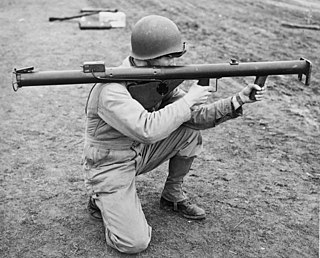 W
WBazooka (/bəˈzuːkə/) is the common name for a man-portable recoilless anti-tank rocket launcher weapon, widely deployed by the United States Army, especially during World War II. Also referred to as the "Stovepipe", the innovative bazooka was among the first generation of rocket-propelled anti-tank weapons used in infantry combat. Featuring a solid-propellant rocket for propulsion, it allowed for high-explosive anti-tank (HEAT) warheads to be delivered against armored vehicles, machine gun nests, and fortified bunkers at ranges beyond that of a standard thrown grenade or mine. The universally-applied nickname arose from the M1 variant's vague resemblance to the musical instrument called a "bazooka" invented and popularized by 1930s U.S. comedian Bob Burns.
 W
WBL755 is a cluster bomb developed by Hunting Aircraft that contains 147 parachute-retarded high explosive anti-tank (HEAT) submunitions. Its primary targets are armoured vehicles and tanks with secondary soft target capabilities. It entered service with the Royal Air Force (RAF) in 1973.
 W
WThe Blacker Bombard, also known as the 29-mm Spigot Mortar, was an infantry anti-tank weapon devised by Lieutenant-Colonel Stewart Blacker in the early years of the Second World War.
 W
WThe Carl-Gustaf recoilless rifle, designated in Swedish service as the Granatgevär m/48, is an 84-mm man-portable reusable anti-tank weapon originally produced by Carl Gustafs Stads Gevärsfaktori in Sweden. Developed in 1946, it was one of the many recoilless rifle designs of that era. While similar weapons have generally disappeared from service, the Carl-Gustaf is still in production and remains in widespread use today. The Carl-Gustaf is a lightweight, low-cost weapon that uses a wide range of ammunition, which makes it extremely flexible and suitable for a wide variety of roles.
 W
WThe CBU-100 Cluster Bomb is an American cluster bomb which is employed primarily in an anti-tank mode. It weighs 222 kg and carries 247 Mk 118 Mod 1 bomblets.
 W
WThe Shitotsubakurai lunge mine was a suicidal anti-tank weapon developed and used by the Empire of Japan during the Second World War. It used a HEAT type charge. This weapon was used by the CQC units of the Imperial Japanese Army. The weapon itself was a conical hollow charge anti-tank mine, placed inside a metallic container and attached to the end of a wooden stick. The weapon was officially adopted by the Japanese Army in 1945; in that year it caused its first victims in the Pacific Theater, where it commonly saw action against American armour. Later that year, some Japanese Imperial Army manuals of the weapon were discovered by US troops.
 W
WThe M60 recoilless gun is an 82-mm antitank recoilless gun developed in the former Yugoslavia. It entered service with the Yugoslav People's Army in the 1960s.
 W
WThe Model 1968 recoilless gun is a 105-mm antitank weapon developed and employed by Argentina. The weapon has been in active service since 1968 and 150 were still operational with Argentine forces as of 2000. A similar weapon is the Argentine 105-mm Model 1974 FMK-1 recoilless gun.
 W
WThe Projector, 2.5 inch—more commonly known as the Northover Projector—was an ad hoc anti-tank weapon used by the British Army and Home Guard during the Second World War.
 W
WThe Pansarvärnspjäs 1110 is a Swedish 90 mm recoilless gun also widely known as Pv-1110. It entered service at the early 1960s and was phased out of service in the Swedish Army in the late 1990s after 1,600 had been produced. Some 300 weapons were transferred to Estonia, Latvia and Lithuania.
 W
WThe Panzerfaust was an inexpensive, single shot, recoilless German anti-tank weapon of World War II. It consisted of a small, disposable pre-loaded launch tube firing a high-explosive anti-tank warhead, and was intended to be operated by a single soldier. The Panzerfaust's direct ancestor was the similar, smaller-warhead Faustpatrone ordnance device. The Panzerfaust was in use from 1943 until the end of the war, continuing to see service outside of Germany for a number of years.
 W
WPanzerschreck was the popular name for the Raketenpanzerbüchse 54, an 88 mm reusable anti-tank rocket launcher developed by Nazi Germany in World War II. Another earlier, official name was Ofenrohr.
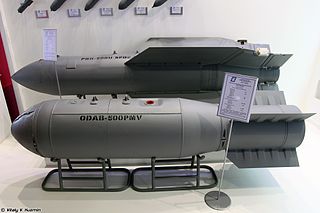 W
WThe PBK-500U Drel is an inertial and GLONASS-guided cluster glide bomb developed by the Russian Federation, designed to destroy enemy armored vehicles and buildings. Drel is equipped with friend or foe identification system and electronic countermeasures making it resistant to jamming and radar detection and is planned to be introduced to the Russian military in 2018. Bazalt considers equipping Drel with a pulsejet engine to increase its range.
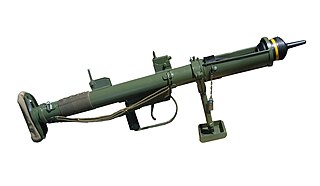 W
WThe Projector, Infantry, Anti Tank (PIAT) Mk I was a British man-portable anti-tank weapon developed during the Second World War. The PIAT was designed in 1942 in response to the British Army's need for a more effective infantry anti-tank weapon and entered service in 1943.
 W
WA recoilless rifle, recoilless launcher or recoilless gun, sometimes abbreviated "RR" or "RCL" is a type of lightweight artillery system or man-portable launcher that is designed to eject some form of countermass such as propellant gas from the rear of the weapon at the moment of firing, creating forward thrust that counteracts most of the weapon's recoil. This allows for the elimination of much of the heavy and bulky recoil-counteracting equipment of a conventional cannon as well as a thinner-walled barrel, and thus the launch of a relatively large projectile from a platform that would not be capable of handling the weight or recoil of a conventional gun of the same size. Technically, only devices that use spin-stabilized projectiles fired from a rifled barrel are recoilless rifles, while smoothbore variants are recoilless guns. This distinction is often lost, and both are often called recoilless rifles.
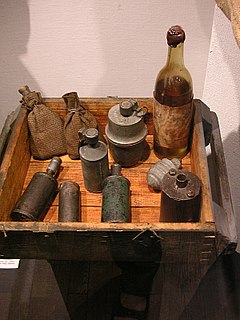 W
WA satchel charge is a demolition device, primarily intended for combat, whose primary components are a charge of dynamite or a more potent explosive such as C-4 plastic explosive, a carrying device functionally similar to a satchel or messenger bag, and a triggering mechanism; the term covers both improvised and formally designed devices.
 W
WA shaped charge is an explosive charge shaped to focus the effect of the explosive's energy. Different types of shaped charges are used for various purposes such as cutting and forming metal, initiating nuclear weapons, penetrating armor, or perforating wells in the oil and gas industry.
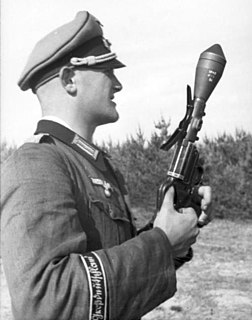 W
WThe Sturmpistole (Assault-Pistol) was an attempt by Germany during World War II to create a multi-purpose weapon which could be used by any infantryman. It consisted of a modified Leuchtpistole or flare gun in English which could fire a variety of grenades, including a 600 g shaped charge Panzerwurfkörper 42 which could penetrate 80 mm of rolled homogeneous armor. The idea was not pursued wholeheartedly, and took second stage to the then current anti-tank rifles and later weapon developments, such as the Panzerfaust and Panzerschreck.
 W
WThe Vickers Class "S" was a 40 mm (1.57 in) cannon used to arm British aircraft for attacking ground targets in the Second World War.